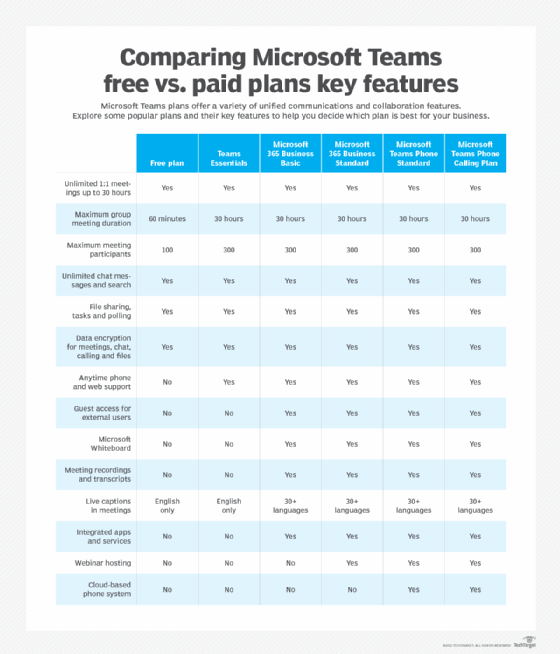
Getty Images
Comparing Microsoft Teams free vs. paid plans
While Teams is bundled with some Microsoft 365 licenses, it does offer a free plan. Learn the difference between Teams free vs. paid plans and which is right for your organization.
Like many collaboration services, Microsoft offers a freemium version of Teams. But organizations using the free version of the service must understand they lack access to certain capabilities. Some organizations may be satisfied with the features available in the free version, while others may consider upgrading.
Organizations are in constant communication in today's fast-paced environment. Many who are using mobile devices and desktop computers have turned to collaboration tools like Microsoft Teams for instant messaging, file sharing and audio/video conferencing. But these features have different levels of availability depending on which plan or license they purchase. Companies with little collaboration platform experience have several factors to consider when evaluating Teams.
Get to know Microsoft Teams free features
While it may appear that the free version of Teams offers limited features, the reality is it has ample features to support many communication and collaboration needs. The free version of Microsoft Teams includes the following features:
- support for unlimited group meetings up to 60 minutes;
- support for unlimited 1-to-1 meetings up to 30 hours;
- live captions in meetings (English language only);
- up to 100 participants per meeting;
- unlimited chat with team members and external users; and
- 5 GB of cloud storage per team.
With the availability of chat, video calls and support for large meetings, the Teams free plan can be an ideal option for organizations starting their collaboration journey. Without any initial licensing investment, the only requirement for an organization would be a strong adoption strategy that includes training and proper configuration of the tools.
Understand Microsoft Teams paid plan features
The paid version of Teams is offered at different pricing tiers and includes more capabilities. Some of these plans are also included with Microsoft 365 licenses. The higher-tier plans, like Microsoft Teams Phone with Calling Plan, include more advanced capabilities found in unified communications suites. Some companies may find these more advanced features more valuable than those in the free version, including the following:
- unlimited group meetings for up to 30 hours;
- up to 300 participants per meeting;
- 10 GB of cloud storage per user;
- 24/7 phone and web support;
- Microsoft Whiteboard;
- free and paid collaborative apps;
- live captions for more than 30 languages;
- meeting recording and transcripts; and
- Teams voice calling to replace VoIP systems.

When to upgrade to a paid Microsoft Teams plan
Organizations upgrading from a free plan must focus on three areas when weighing all the options available across Teams paid plans: security, business apps and calling features. These are areas where organizations may have more complex needs or must meet regulatory requirements. IT must evaluate which of the components are required within their organization and then determine which plan is the right fit.
Microsoft bundles Teams with its Office 365 small business and enterprise plans, which enables the communications provider to drive up adoption. Organizations that need more features than are available in their bundled plan can opt for add-on licenses to enable functionality, such as calling or additional security features. Whether free or paid, the Teams platform can provide all collaboration features an organization needs. Businesses should carefully evaluate their options and select the right plan for their collaboration needs.







